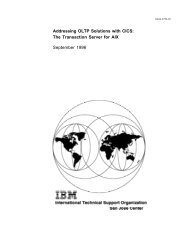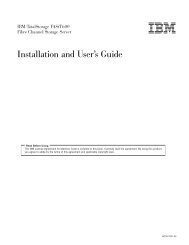IBM IntelliStation - ps-2
IBM IntelliStation - ps-2
IBM IntelliStation - ps-2
Create successful ePaper yourself
Turn your PDF publications into a flip-book with our unique Google optimized e-Paper software.
Updated 07/01/03<br />
For the latest product & technical information, refer to the Information Sources on pages 2 & 3.<br />
231<br />
System IDE Connections SCSI Connections Media Int RAID<br />
x335 IDE<br />
1<br />
2<br />
CD-ROM<br />
IDE HDD<br />
1-drop<br />
2-drop<br />
-<br />
1 IDE HDD<br />
-<br />
-<br />
-<br />
-<br />
-<br />
-<br />
-<br />
-<br />
-<br />
-<br />
-<br />
-<br />
-<br />
-<br />
-<br />
-<br />
-<br />
-<br />
-<br />
-<br />
-<br />
-<br />
-<br />
-<br />
N/A<br />
-<br />
x335 H/S SCSI 1 CD-ROM 1-drop - 1 U320 Y 1 A I 68-pin H/S backplane 1-drop N3 - - Y<br />
x343<br />
(NEBS)<br />
1<br />
-<br />
CD-ROM<br />
-<br />
1-drop<br />
-<br />
-<br />
-<br />
1<br />
-<br />
U160<br />
-<br />
Y<br />
-<br />
2<br />
-<br />
A<br />
B<br />
I<br />
E<br />
68-pin<br />
0.8mm<br />
VHDCI<br />
1 NH/S SCSI HDD<br />
ext SCSI device<br />
2-drop<br />
-<br />
Y<br />
-<br />
-<br />
-<br />
-<br />
-<br />
-<br />
-<br />
1 CD-ROM 1-drop - 1 U320 Y 2 A I 68-pin H/S backplane 1-drop N<br />
x345<br />
3<br />
- - Y 26<br />
- - - - B E<br />
0.8mm<br />
VHDCI<br />
ext SCSI device - - - - -<br />
x360 1 CD-ROM 1-drop 14<br />
- 1 U160 Y 1 A I Integrated H/S backplane 15<br />
- - - - Y 16<br />
1 CD-ROM n/a<br />
x440<br />
17<br />
- 1 U160 Y 2 A I 68-pin H/S backplane 1-drop N 3<br />
- - Y 18<br />
2 FDD n/a17 - - - - - B E<br />
0.8mm<br />
VHDCI<br />
ext SCSI device - - - - -<br />
1 DVD-ROM n/a<br />
x445<br />
17 - 1 U320 Y 2 A I 68-pin H/S backplane 1-drop N3 - - Y18 2<br />
FDD or<br />
optical<br />
n/a 17<br />
- - - - - B E<br />
0.8mm<br />
VHDCI<br />
ext SCSI device - - - -<br />
x450<br />
1. IDE controllers have two channels, generally with one connector per channel. Standard IDE cables include two dro<strong>ps</strong>. Some IDE devices, e.g., a slim-line CD-ROM, use a single-drop ribbon cable, which is soldered to a backplane instead of using a<br />
connector at the device end of the cable.<br />
2.The term drop refers to a device connector on a cable. The connector that attaches to the controller is not counted as a drop.<br />
3. Termination is provided by the hot-swap backplane.<br />
4. Attaching a SCSI tape drive to the same SCSI bus as the HDDs may reduce performance. Slim-line tape drives may be supported in bay four (see the system Tape Options section).<br />
5. An additional cable to connect SCSI devices installable in internal removable media bays to the standard SCSI storage controller may be required when the standard SCSI cable is used to connect an optional RAID adapter. The necessary cable is<br />
provided in the option specified in this column, or if a tape drive is the media device being connected, a 34in terminated SCSI cable is now provided with the tape option.<br />
6. If installing an IDE tape drive, the standard IDE cable is used (maximum number of IDE optical drives or HDDs is reduced by one because only two IDE connectors are provided on each of the two IDE cables). If installing an internal SCSI device, a<br />
supported SCSI storage controller is required. The single-channel Ultra160 SCSI adapter (P/N 19K4646) includes a 16-bit five-drop terminated multimode SCSI cable and a 0.8mm VHDCI external connector. Single channel Ultra320 SCSI Controller (P/N<br />
71P8594) provides a single channel with one 68-pin internal connector, a four-drop multimode terminated LVD SCSI cable and one external 0.8mm VHDCI connector.<br />
7. If installing an IDE tape drive, the second connector of the standard IDE cable can be used. If installing a SCSI device, one connector of the five-drop SCSI cable can be used, which may adversely affect performance for the entire SCSI bus. Installing<br />
the tape drive on an independent bus requires an optional controller (P/N 19K4646 or 71P8594) unless the HDDs are attached to a RAID controller.<br />
8. Half-high SCSI devices installed in the media bay require an additional storage controller (P/N 19K4646 or 71P8594), which provides a single SCSI and a five-drop terminated cable.<br />
9. In nonhot-swap models, SCSI RAID adapters are connected to one end of the standard SCSI cable. When the standard cable is used to attach to the RAID adapter, media bay attachment to the standard SCSI controller for SCSI devices in nonhot-swap<br />
models of x205 require the one-drop terminated LVD cable provided with the tape drive.<br />
10. SCSI RAID adapters are generally connected to the hot-swap backplane using the standard cable that connects the integrated storage controller. When the standard cable is used for RAID attachment, media bay attachment requires the one-drop<br />
terminated LVD cable provided with the tape drive.<br />
11. In xSeries 225, the standard cable connecting either the hot-swap backplane or the nonhot-swap HDDs is used to connect the HDDs to ServeRAID-4H, -4Mx or -4Lx. If ServeRAID-5i is installed, a cable is not required and both channels of the<br />
integrated controller are managed by the adapter.<br />
12. Attachment of SCSI devices in either (or both) of the two available media bays requires a supported optional SCSI storage controller (P/N 19K4646 or 71P8594) in non-RAID configurations. Two half-high or one full-high device may be installed. A twodrop<br />
SCSI cable is included with the server, which can be used to attach one or two internal tape options to the integrated controller when a ServeRAID adapter is used to support the hot-swap backplane.<br />
13. Attachment of tape or optical drives to RAID adapters is not supported.<br />
14. The standard slim-line CD-ROM docks directly into a media interposer card that is routed through the lightpath card before terminating at the planar.<br />
15. The hot-swap backplane is connected to the integrated controller through a SCSI bus integrated into the system planar.<br />
16. Internal RAID configurations are supported by connecting an internal connector on the RAID controller to a connector on the planar located between slot one and the memory card using a dedicated RAID cable provided with the system. (Route cable<br />
underneath PCI adapters.) Note: If the hot-swap backplane is attached to a RAID adapter, a full-length adapter cannot be installed in slot one.<br />
17. Shi<strong>ps</strong> with a slim-line UltraBay 2000 optical drive installed in bay 4 (lower right of four bays). Bay three (lower left bay) supports either an UltraBay 2000 floppy disk drive (FDD) or optical drive. FDDs can be installed in bay three only, but optical devices<br />
can be installed in either bay. If only one optical device is installed, it must be located in bay four. If two are installed, the standard FDD is removed and the second device is installed in bay three configured as slave.<br />
18. If the hot-swap backplane is attached to a RAID adapter, the standard SCSI cable is replaced by a longer cable shipped with the system.<br />
19. Channel B may be connected to a supported tape drive installed in the media bay if ServeRAID-5i is installed and channel B is designated to support SCSI during the setup or if RAID is not implemented (cable shipped with tape drive is used). If<br />
channel B is available, a 0.8mm VHDCI external SCSI port can be enabled by installing External SCSI Interface Kit (P/N 32P8164). The external port is then operated as a SCSI channel supporting external tape storage or as a RAID channel supporting<br />
external HDD storage.<br />
Internal Cabling Overview<br />
1<br />
2<br />
DVD-CD/<br />
RW<br />
FDD or<br />
optical<br />
n/a 17<br />
n/a 17<br />
- 1 U320 Y 2 A I 68-pin H/S backplane 1-drop N 3<br />
- - - - - B E<br />
0.8mm<br />
VHDCI<br />
- - N 27<br />
ext SCSI device - - - - -

















